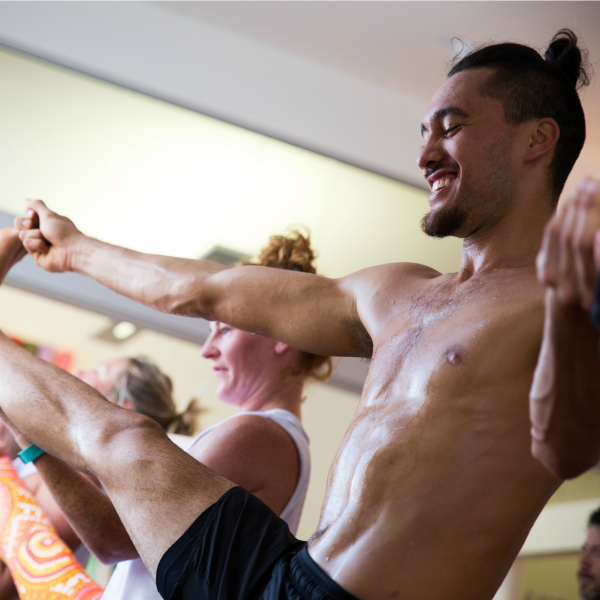12 May Why You Should Never Ever Miss Your Savasana

Savasana – for some yogis, the most anticipated words at the end of every yoga class. Blissful rest after a strong, sweaty class. For others, this resting pose creates more of a challenge. A thousand thoughts flood into your head and all you want to do right now is get up and leave, but not lay still. Others find it utterly boring. Who needs rest anyway? Let’s skip it and get back into our day. Especially tempting when practicing at home, and no one is watching. So here’s some insight into why we rest at the end of class, why you shouldn’t skip savasana, and what its enormous benefits are. You’ll never want to skip savasana again.
First of all, savasana or corpse pose is a pose of complete relaxation generally at the end of your yoga asana practice. And as the name already predicts, it is lying in absolute stillness in body and your mind. Usually, our bodies are somewhat relieved after a strong, vigorous class to have a rest and just be. Our minds, on the other hand, well, that’s when it gets tricky. Savasana is referred to as the most important pose in yoga asana, but also one, if not, THE most difficult one. Why is that? We’ll get to that later on. But first, let’s begin with the good stuff.
The benefits of your savasana.
You’ve sweated and moved your body through your asana practice and it’s during the final pose that your whole being will take in all the effects of the practice: emotionally, mentally and physically.
Benefits of savasana include a decrease in your blood pressure and heart rate. Your nervous system calms down, easing any anxious feelings to leave you in a state of calm, feeling both more collected and energised afterwards. In short, just like your overall yoga practice, savasana has the same enormous benefits for your mental health.
When interviewed by Yoga Journal, world-renown teachers’ teacher Annie Carpenter sums it up perfectly. She says, that “savasana is the great balancer in terms of our nervous system: while much of asana practice is designed to up-regulate the body, stimulate, and even provide healthy stress, Savasana is the down-regulator. It shifts the away from the sympathetic nervous system (flight and fight mode) to the parasympathetic (rest and digest mode), and we experience a calming, sweet release.”
Why is savasana so tricky sometimes?
First of all, don’t worry if you are struggling with savasana. Most yogis do. Secondly, if we are honest, relaxation on demand is not easy sometimes. During a yoga flow class, we are always moving, breathing and pretty much occupied until the very end. And as soon as we should lie down and do nothing? Well, our busy heads go into overdrive. That’s when it can become quite uncomfortable.
Rather than getting hung up on how challenging this pose is for you, see it as a treat or as your rare chance to just be. There is nothing for you to do, nowhere to be. When does that otherwise happen in your busy everyday life? We are usually so caught up in doing, rushing, moving not only through our days but also in our asana practice. Hence savasana is your chance to relax and let go of any tension in your body and mind. An opportunity to let go of any thoughts about or labelling your practice. Or life in general. It’s your time to lie with your thoughts and emotions without trying to change or manipulate or attaching to them. Stay in the present moment. And isn’t that what yoga is all about? Savasana requires us to be still, to listen within and to receive. Sometimes that will be being comfortable with the uncomfortable. You’ll be ready to handle any challenges in your life with more ease.
The most crucial advice, however, is, no matter how big the struggles and restlessness you are facing in your resting pose: don’t give up. Try to focus on your deep breaths; let your body slowly ease into stillness and also, give your mind something to focus on. It will quieten down slowly but surely. Some yogis visualize their body getting heavy and melting into the mat. We have got a special treat of guided Yoga Nidra – yogic sleep – further down below to completely relax your whole body. It’s better than restorative sleep.
Indulge in your savasana.
One of the best things about your current home practice is not only that you can extend your savasana as long as you want, but you can also make it the best ever.
You have all the props to get super comfy and support the release and quieten the mind. Use jumpers, beanies, blankets, pillows to assist you and keep you warm and cosy. Place an eye pillow over your eyes. Maybe even place a bolster or a few pillows or blankets on top of you can help nurture a more grounding and inward sensation that can support you in soothing your emotions and calming your mind. Burn incense or diffuse your favourite calming oils like lavender or frankincense. It’s your practice, hence use whatever you need to create a safe space for your whole being to let go and completely relax.
Do not skip your savasana. Ever.
Savasana. Yes, it is challenging and blissful at the same time. The feeling when you slowly come out of a deep and long savasana is priceless. You feel totally zen, peaceful, well-rested, energised and content at the same time. You breathe, stretch, open up and twist your body into various pretzel shapes or not and sweat on your mat, to finally find rest.
That sweet pause completes your practice during which every cell of your body, mind and nervous system can absorb the effects of the practice. Time stands still for the practice to land in every fibre of your being and you to just be, whatever comes up for you. In the end, don’t let the struggles of savasana take you down; everyone has them. Just don’t skip it. Even a quick one is better than none at all. And you never know, the most relaxing savasana may be at the end of your next practice!
Can’t get enough of savasana? Let us introduce you to Yoga Nidra.
Yoga Nidra – the yogic sleep.
It’s probably the most underrated but yet most powerful and most accessible meditation practice there is. All you need to do is lie down and get super comfy and listen to your teacher’s voice, guiding you through the practice. Yoga Nidra usually consists of breathwork, a body scan, setting an intention from the heart and visualisation. It is said that 1 hour of Yoga Nidra is equivalent to 4 hours of restorative sleep. You will feel rested, completely calm and rejuvenated – ready to take the rest of your day. You can take a Yoga Nidra intermission during your busy day or just before bedtime easing yourself into a blissful night of sleep. And don’t worry if you fall asleep, happens to the best of us. Now let Shauna guide you through a 10 minute Yoga Nidra practice. You will see, it’s better than sleep.
Don’t skip your next savasana, yogis!
Written by Bettina Simbuerger



